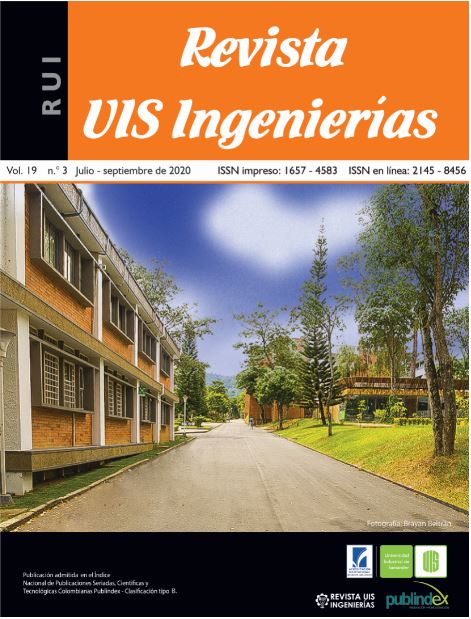Thermodynamic optimization of heat transfer in internal gas flow with conical ring inserts
Published 2020-05-22
Keywords
- optimization,
- inserts,
- conical rings,
- subsonic heating,
- second law
How to Cite
Copyright (c) 2020 Revista UIS Ingenierías

This work is licensed under a Creative Commons Attribution-NoDerivatives 4.0 International License.
Abstract
The use of static inserts allows reducing the volume of heat exchangers at the design stage, although they could also be installed in operating equipment to enhance their performance. In this work, an original methodology is developed for the thermodynamic optimization of conical ring inserts within cylindrical piping for gas heating, using a dimensionless algebraic model. Two optimization cases are considered: the design of a new heat exchanger, and the retrofitting of an operating equipment. In the former only the mass flow, charge temperature and heat rate are known, whereas all geometrical characteristics are fixed for the latter. As results, this article presents a parametric study for discharge temperature and entropy generation, and the result of optimization methodology applied to several parameter combinations. The trends observed for optimal configurations are discussed and an example is solved to illustrate the practical value of the proposed methodology. It was found that optimum configuration leads to less severe inserts, and that best designs are those with lower pipe aspect ratio (L/D), while the tube count, used in Reynolds number calculation, is adjusted to meet temperature requirements.
Downloads
References
[2] R. M. Manglik, A. E. Bergles, “Heat Transfer and Pressure Drop Correlations for Twisted-Tape Inserts in Isothermal Tubes: Part II—Transition and Turbulent Flows,” J. Heat Transfer, vol. 115, no. 4, pp. 890–896, 1993, doi: 10.1115/1.2911384
[3] A. Bejan, Entropy Generation Minimization: the Method of Thermodynamic Optimization if Finite-size Systems and Finite-time Processes. Boca Ratón, NY, USA: CRC Press, 1996.
[4] A. E. Bergles, M. K. Jensen, E. Somerscales, R. M. Manglik, “Literature Review of Heat Transfer Enhancement Technology for Heat Exchanges in Gas-Fired Applications,” Instituto de Investigación del Gas, Chicago, IL, USA, Rep. GRI 91-0146, 1991.
[5] A. E. Bergles, Techniques to Enhance Heat Transfer, disponible en Handbook of Heat Transfer, 3ra ed. Nueva York, NY, USA: McGraw-Hill, 1998.
[6] R. M. Manglik, Heat Transfer Enhancement vol. 1., Cincinnati, OH, USA:John Willey & Sons, Inc., 2003.
[7] S. Chikh, N. Allouache, “Optimal performance of an annular heat exchanger with a porous insert for a turbulent flow,” Appl. Therm. Eng., vol. 104, pp. 222–230, 2016, doi: 10.1016/j.applthermaleng.2016.05.069
[8] M. Hatami, D. D. Ganji, M. Gorji-Bandpy, “Investigations of fin geometry on heat exchanger performance by simulation and optimization methods for diesel exhaust application,” Neural Comput. Appl., vol. 27, no. 6, pp. 1731–1747, 2016, doi: 10.1007/s00521-015-1973-1
[9] L. Wang, B. Sundén, “Performance comparison of some tube inserts,” Int. Commun. Heat Mass Transf., vol. 29, no. 1, pp. 45–56, 2002, doi: 10.1016/S0735-1933(01)00323-2
[10] S. Sanaye, H. Hajabdollahi, “Multi-objective optimization of shell and tube heat exchangers,” Appl. Therm. Eng., vol. 30, no. 14–15, pp. 1937–1945, 2010, doi: 10.1016/j.applthermaleng.2010.04.018
[11] H. Najafi, B. Najafi, P. Hoseinpoori, “Energy and cost optimization of a plate and fin heat exchanger using genetic algorithm,” Applied thermal Engineering, vol. 31, no. 10, pp. 1839-1847, 2011, doi: 10.1016/j.applthermaleng.2011.02.031
[12] U. Milovancevic, B. Jacimovic, S. Genic, F. El-Sagier, M. Otovic, S. Stevanovic, “Thermoeconomic analysis of spiral heat exchanger with constant wall temperature,” Therm. Sci., vol. 23, no. 1, pp. 401–410, 2019, doi: 10.2298/TSCI170605150M
[13] C. Casarosa, “Thermoeconomic optimization of heat recovery steam generators operating parameters for combined plants,” Energy, vol. 29, no. 3, pp. 389–414, 2004, doi: 10.1016/S0360-5442(02)00078-6
[14] D. Eryener, “Thermoeconomic optimization of baffle spacing for shell and tube heat exchangers,” Energy Convers. Manag., vol. 47, no. 11–12, pp. 1478–1489, 2006, doi: 10.1016/j.enconman.2005.08.001
[15] M. Di Somma et al., “Design optimization of a distributed energy system through cost and exergy assessments,” Energy Procedia, vol. 105, pp. 2451–2459, 2017, doi: 10.1016/j.egypro.2017.03.706
[16] G. Tsatsaronis, L. Lin, J. Pisa, “Exergy Costing in Exergoeconomics,” J. Energy Resour. Technol., vol. 115, no. 1, pp. 9–16, 1993, doi: 10.1115/1.2905974
[17] P. K. Nag, P. Mukherjee, “Thermodynamic optimization of convective heat transfer through a duct with constant wall temperature,” Int. J. Heat Mass Transf., vol. 30, no. 2, pp. 401–405, Feb. 1987, doi: 10.1016/0017-9310(87)90128-1
[18] P. Mukherjee, G. Biswas, P. K. Nag, “Second-Law Analysis of Heat Transfer in Swirling Flow Through a Cylindrical Duct,” J. Heat Transfer, vol. 109, no. 2, pp. 308–313, 1987, doi: 10.1115/1.3248081
[19] M. Li, A. C. K. Lai, “Thermodynamic optimization of ground heat exchangers with single U-tube by entropy generation minimization method,” Energy Convers. Manag., vol. 65, pp. 133–139, 2013, doi: 10.1016/j.enconman.2012.07.013
[20] K. Altfeld, W. Leiner, M. Fiebig, “Second law optimization of flat-plate solar air heaters Part I: The concept of net exergy flow and the modeling of solar air heaters,” Sol. Energy, vol. 41, no. 2, pp. 127–132, 1988, doi: 10.1016/0038-092X(88)90128-4
[21] P. Promvonge, “Heat transfer behaviors in round tube with conical ring inserts,” Energy Convers. Manag., vol. 49, no. 1, pp. 8–15, 2008, doi: 10.1016/j.enconman.2007.06.009
[22] F. Incropera, D. Dewitt, Fundamentals of heat and mass transfer 6th Ed. Jefferson city, MO, USA: John Wiley & Sons, 2007.
[23] M. N. Khalaji, I. Kotcioglu, S. Caliskan, A. Cansiz, “The Second Law Analysis of Thermodynamics for the Plate–Fin Surface Performance in a Cross Flow Heat Exchanger,” J. Heat Transfer, vol. 141, no. 1, 2019, doi: 10.1115/1.4041498
